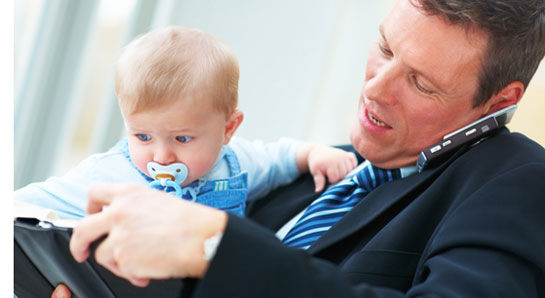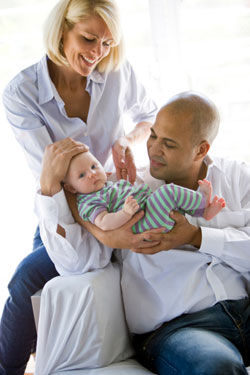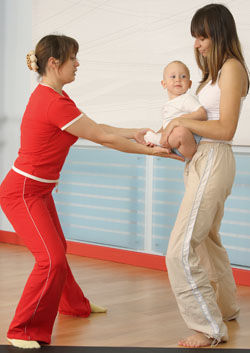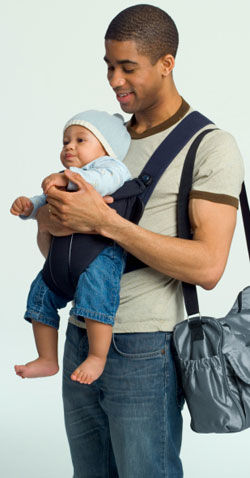
By TODD GALATI, M.A.
Parenthood, it could be argued, is the ultimate test of an individual’s stamina. All day, every day, for the rest of their lives, parents are “on the job.” The physical demands of this job are particularly taxing in the early years. Starting shortly after a child is born, parents begin a daily ritual of postural distortion that can eventually lead to long-term imbalances. Watch a mother holding an infant and you will often see her holding the baby in one arm while tending to the baby’s needs with the free hand. Look at her posture and you will see a combination of swayback with thoracic rotation to the side of the arm holding the child, with the neck in a flexed, laterally flexed, and slightly rotated position so she can watch the baby. It is not uncommon for parents to spend hours each day in this position, generally holding the child in the same arm with the head and spine offset to the same side. Over time, this repeated position can lead to changes in the length and strength of the involved muscles, resulting in altered posture, and joint stability and mobility issues. Then, as the child grows, the load imbalance increases, exacerbating the situation.

Parents also face additional challenges that can include irregular schedules, interrupted or minimal sleep, less-than-healthy meals, and a lack of time for exercise and other leisure activities. This can quickly result in a loss of fitness and increased stress to go along with the postural issues. All of these factors should be considered when working with a client who has a young baby, especially when she or he carries the child on a regular basis. While it is common for mothers to be the primary caregiver, it is important to remember that fathers are also impacted and to be mindful that each parent’s experience and programming needs will be unique.
Many parents have difficulty finding the time or energy to exercise, and some feel guilty taking time away from the baby or family to exercise. It is important for fitness professionals to help these parents realize that physically active parents, especially mothers, can feel less overwhelmed, have better self-images, and are more ready to master parenthood.
Special Considerations for Exercise during the Initial Postnatal Period
The American Congress of Obstetricians and Gynecologists (ACOG) developed general guidelines for postnatal exercise, recognizing that many of the physiological and morphological changes of pregnancy persist for four to six weeks postpartum. Exercise routines performed during pregnancy should only be resumed gradually based upon the woman’s physical capabilities. Dr. James F. Clapp III, a research professor of obstetrics and gynecology at the University of Vermont and author of Exercising Through Your Pregnancy, suggests that the initial goal of exercise during the first six weeks postpartum should focus on redeveloping a sense of control by obtaining personal time. After the first six weeks postpartum, Dr. Clapp suggests that exercise goals should focus on improving fitness. The difficulty of the delivery and recovery, especially with C-section births, can alter this timeline a bit. Therefore, participation in a structured exercise program should wait until the mother has received her physician’s clearance after the six-week postpartum checkup.
Rapport and Investigation

Rapport is the foundation of successful client–trainer relationships. An important step in this process with a new parent involves taking the time to learn about his or her current lifestyle and how it differs from before the baby was born. Items to discuss include sleeping, eating and physical activity. Don’t be surprised to find some or all of these to be inconsistent on a weekly or daily basis. It is also important to find out what support the client has from family and friends for exercise and other activities. Good support can play a critical role in allowing the client to feel comfortable about taking time to exercise a few days per week. Find out the days and times that the client has available to exercise and help her or him to establish realistic goals that can be accomplished in the available time. Help the client to prepare for missed sessions and setbacks, and offer alternative workouts that can be done at home when the unexpected occurs.
Be sure to ask about any physical changes that the client has noticed since the baby was born. This can include fatigue, a lack of exercise, increased weight, and aches from carrying the baby for extended periods. Additional considerations for mothers include pregnancy-related body changes, lactation and recovery from childbirth, especially following a C-section delivery. A physician’s clearance should be required for any risk factors or conditions that would normally require medical evaluation prior to exercise, and for female clients who are within the first few months of the postpartum period, had a C-section, or had complications during pregnancy or delivery.
Focus First on Posture
Parents carry their children frequently during the first few years, often holding them predominantly in one arm. As the child gets bigger, it is common for parents to rest them on one hip while providing support with the same side (ipsilateral) arm. To do this, they contract the adductors of the ipsilateral hip and abductors of the opposite (contralateral) hip, jamming the pelvis out and shifting the weight of the upper body to the opposite side to allow room for the child’s torso and head. This will eventually lead to shorter adductors and weaker abductors on the side where the child is held and shorter abductors and weaker adductors on the contralateral side. Decreased mobility in the hip joints can cause a long-term shift of the pelvis to the side where the child is normally held, which can cause instability in the adjacent segments of the kinetic chain—the lumbar spine and the knees. This is one example of how carrying a child can, over time, lead to postural issues.
Before focusing too much time on trying to teach clients how to hold their children correctly all of the time, first realize that holding and tending to a baby is an ergonomically challenging endeavor. With this in mind, teach clients to switch arms when possible, work with them on carrying positions that utilize better posture and keep the legs, glutes and core engaged, and suggest using an ergonomic baby carrier that balances weight over their center of gravity. This will help parents become more aware of the way they carry their children; however, to truly help them you will have to first determine what postural deviations, if any, exist, identify any limitations in range of motion through flexibility assessments and movement screens, and assess whether or not they can engage their core muscles to brace the torso. Once you have this information, you can utilize phases 1 and 2 of the ACE Integrated Fitness TrainingTM (ACE IFTTM) Model to design and then progress their initial exercise programs.
ACE IFT Model – Functional Movement and Resistance Training – Phase 1
Clients who have postural imbalances or compromised joint function should be categorized into Functional Movement and Resistance Training Phase 1 of the ACE IFT Model. Clients should first be able to actively engage their transverse abdominis by drawing in the abdomen in supine and quadruped positions, and performing pelvic floor contractions (kegels). Clients can then perform complete phase 1 workouts for postural stability and mobility. Encourage clients to engage their core when lifting, carrying and holding their baby and other objects. This sample Postural Workout for Parents is comprised of exercises from Functional Movement and Resistance Training Phase 1.
ACE IFT Model – Cardiorespiratory Training – Phase 1
Clients who are not currently performing regular cardiorespiratory exercise should start by training in the Cardiorespiratory Training Phase 1 of the ACE IFT Model. The most important aspect of training in this phase is helping clients to have positive experiences with exercise so they want to continue. This is critical for parents who are struggling to find the time and drive to exercise. They need the motivation of positive energy from exercise to help them continue to adhere to their workout sessions.
The cardiorespiratory training focus of this phase is on developing an aerobic base to first improve health and stamina, and then to improve fitness to levels that can be built upon during phase 2. Training in this phase should be comprised of steady-state cardiorespiratory exercise performed below the talk test, or first ventilatory threshold (VT1). Encourage clients to perform this steady-state exercise with their babies, pushing them in a stroller or carrying them in an ergonomically designed baby carrier (e.g., Baby Björn). Once clients can perform 20 to 30 minutes of steady-state exercise at just below the talk-test threshold, they can progress to phase 2 training.
Learn more about the talk test by reading the ACE Certified News article, Validating the Talk Test as a Measure of Exercise Intensity and watching the ACE video Cardiorespiratory Training Using the ACE IFT Model.
ACE IFT Model – Functional Movement and Resistance Training – Phase 2
Movement Training is the focus of phase 2 of Functional Movement and Resistance Training in the ACE IFT Model. Once a client’s postural stability and joint mobility have improved, training can be progressed to focus on the correct execution of the five primary movement patterns (bend-and-lift, single-leg, pushing, pulling, and rotational movements) in all three planes of motion. Training will begin primarily with body weight, so the client can learn proper movement patterns prior to adding an external load. As a client develops good movement patterns, begin adding external resistance using cables, medicine balls, bands, etc.
Once clients demonstrate good movement patterns in all planes, they can progress to load training (phase 3), as appropriate based upon their goals. To continue reinforcing good movement patterns, have clients continue to incorporate movement-training exercises as part of their dynamic warm-ups. This sample Total-body Conditioning Workout for Parents provides a sample movement training (phase 2) workout that can be transitioned into a dynamic warm-up as the client progresses on to load training (phase 3). Clients should always be encouraged to use good movement patterns during exercise, and when lifting, carrying, holding, and moving a baby or any other external load.
ACE IFT Model – Cardiorespiratory Training – Phase 2

Clients consistently performing steady-state cardiorespiratory exercise continuously for 20 to 30 minutes can progress to phase 2 of the ACE IFT Model, Cardiorespiratory Training, where the goal is to improve and advance fitness. First, challenge the client by increasing exercise duration, and then introduce brief (30 to 60 seconds) aerobic intervals that push heart rate up to 10 bpm above VT1, or the talk-test threshold. Recovery periods between intervals should be about three times the length of the work interval (e.g., 30-second work interval with 90-second recovery). As fitness improves, gradually increase the work intervals to two to three minutes or more, and reduce the recovery interval to one to two times the length of the work interval (e.g., three-minute work interval with three- to six-minute recovery). The intervals can be achieved through a variety of challenges, including increasing speed and adding hills. As with cardiorespiratory training in phase 1, parents can perform most or all of these workouts with their children, either in strollers or ergonomic baby carriers.
Conclusion
It is important to be mindful that parents often put their fitness, posture, sleep and other needs well below those of their children. Fitness professionals can help clients who have young children to adopt exercise routines that fit their lifestyles and available time, while also improving their posture, movement and fitness. These efforts can go a long way in helping them regain a sense of ‘self’ by allowing them to incorporate exercise into their life as a parent. Not only will this significantly benefit your clients, it will also provide their children with good role models for exercise and active living.
_______________________________________________________________________

Todd Galati, M.A.,is the ACE Director of Academy and former adjunct faculty with the Kinesiology Department at California State University, San Marcos. He also is acutely aware of the postural challenges of parenthood, with two children under the age of four. Galati holds a bachelor’s degree in athletic training and a master’s degree in kinesiology and four ACE certifications (Personal Trainer, Advanced Health & Fitness Specialist, Lifestyle & Weight Management Consultant, and Group Fitness Instructor).